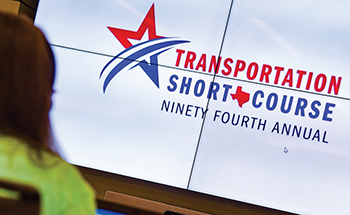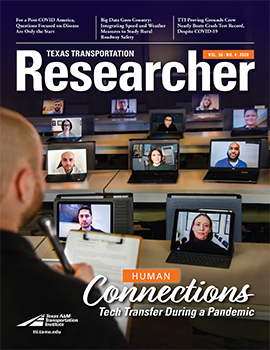Sponsored by the Texas Department of Transportation (TxDOT) and hosted by the Texas A&M Transportation Institute (TTI), the Ninety Fourth Annual Transportation Short Course occurred Oct. 12–14, 2020. The event was held virtually for the first time and brought together a record number of transportation industry experts to share best practices and insights into how the Texas transportation system will evolve in a post-pandemic future.
The transportation planning breakout session looked at the short-term impact of the COVID-19 pandemic across various transportation modes, as well as the long-term implications for what the “new normal” might look like after it’s over.
“This year’s Short Course had new meaning attached to it, beyond our annual get-together to share lessons learned,” notes Unified Transportation Program Portfolio Performance Director Mildred Litchfield of TxDOT’s Transportation Planning and Programming Division. Litchfield co-chaired the session with TTI Executive Associate Director Katie Turnbull and TTI Research Scientist Ed Hard. “Ensuring that the Texas transportation system works as efficiently, safely and resiliently as possible during and after COVID-19 is critical.”
Moderated by Transportation Planning and Program Director James Koch of TxDOT’s Houston District, the first half of the session examined the pandemic’s direct effects on various transportation modes, including vehicular, transit, bike, pedestrian and air travel.
Director of Transportation Michael Morris, North Central Texas Council of Governments (NCTCG), highlighted travel behavior changes in the Dallas–Fort Worth metroplex during the pandemic. He noted the reduction in roadway, toll road, transit and air transportation-related revenues during the shelter-in-place phase and the more recent increase in use. For example, there was a 57 percent reduction in toll road transactions and 92 percent drop in air travel in April 2020. He also emphasized the importance of funding during the recovery phase, stating that $1 billion in transportation investment could lead to 12,000–15,000 new jobs, providing vital relief to currently unemployed individuals.
Houston METRO’s President and CEO Tom Lambert described how transit in the Bayou City has changed, with declines in ridership in all services due to the pandemic. He noted that METRO continues to balance service, especially essential trips, with rider safety and the safety of METRO employees as key considerations. He described actions taken and those underway as METRO’s transit services group responds to changing conditions.
Bicycle and Pedestrian Planner Noah Heath of TxDOT’s Public Transportation Division and NCTCG’s Sustainable Development Program Manager Kevin Kokes shared the stage on the topics of bike and pedestrian traffic. They both stressed the increase in bicycle and pedestrian trips during the pandemic. Bike/ped counts were up by 36 percent through May at selected locations in the state, and the fitness app Strava reported a 99 percent uptick in bike trips in Texas. Both stats confirm anecdotal evidence of increased bike and ped activity as folks explored their neighborhoods during the quarantine to get out of the house, which is also reflected in the shortage of bicycles for sale.
Director Jim Halley of TxDOT Airport Planning and Programming estimated that it will be at least 2023 before air travel will recover, saying the long-term effects of COVID-19 on the industry will last longer than 9/11’s did. Carrier consolidation, operational efficiency optimization and fleet optimization are strategies the airline industry is using to save reserves.
The second part of the session, hosted by Director of Transportation Planning and Development Paula Sales-Evans of TxDOT’s Corpus Christi District, explored the implications for future planning. Experts addressed the topics of funding and financing, environment and land use, automated and connected vehicles, and travel and tourism.
Texas Comptroller of Public Accounts and Chief Revenue Estimator Tom Currah briefed attendees on pandemic trends like gasoline supply and seated diner occupancy, both of which bottomed out in April. He discussed trends in the sources of state highway fund revenues including motor fuel taxes, sales taxes, motor vehicle registration fees and severance taxes. While employment was hit hard in the spring, pre-pandemic employment peaks are expected to return within the next year. He reported that an updated budget forecast will be released before the 2021 Texas legislative session.
The Houston-Galveston Area Council’s Director of Community and Environmental Planning Jeff Taebel discussed the possible impacts of three scenarios, focusing on if remote workers stay remote, if brick-and-mortar retail shopping doesn’t rebound, and if lower-wage jobs continue to bear the brunt during the pandemic without any benefits. How this plays out will have definite impacts on future land use, development and travel patterns.
Director of the Federal Highway Administration’s (FHWA’s) Office of Safety Research and Development and Office of Operations Research and Development Brian Cronin looked at connected and automated vehicles and their potential to improve mobility and safety once widely deployed. He described different elements of FHWA’s CARMA Platform, an open-source software for testing and evaluating cooperative automation concepts aimed at improving system safety and increasing efficiency of the roadside infrastructure.
Director Joan Henderson of TxDOT’s Travel Information Division addressed the pandemic’s devastating impact on travel and tourism in the Lone Star State. Travel spending is down by $519 billion, and the state has suffered an economic loss of approximately $1.2 trillion, suggesting that COVID-19 will have nine times the impact on travel and tourism of 9/11. She described some of the approaches being taken to support safe travel and tourism, including staycations and outdoor activities. Henderson urged everyone to take the Texas Travel Pledge, which stresses safe travel and enjoying Texas responsibly for the welfare of others.
“All the speakers highlighted the importance of collaboration, communication, transparency, flexibility and commitment in responding to the pandemic,” says Turnbull. “They stressed commitment for working together along with other public- and private-sector partners to address short-term issues and to ensure a robust long-term multimodal transportation system to support individual mobility and the movement of goods.”


